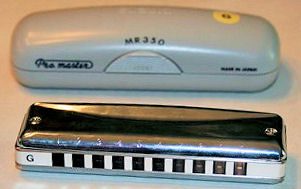
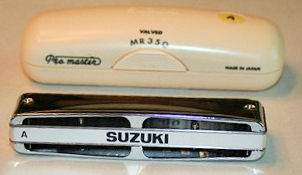
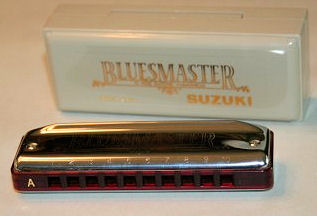
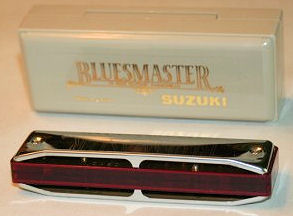
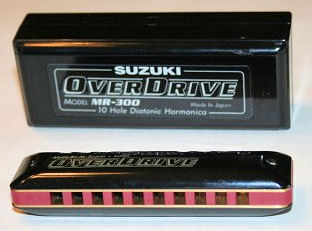
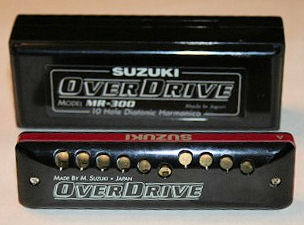
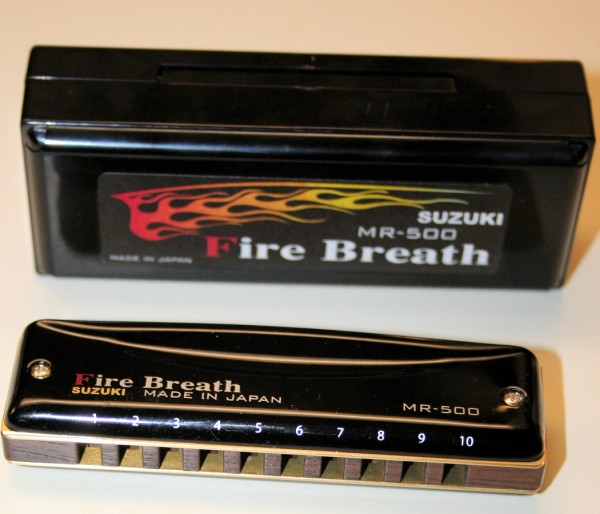
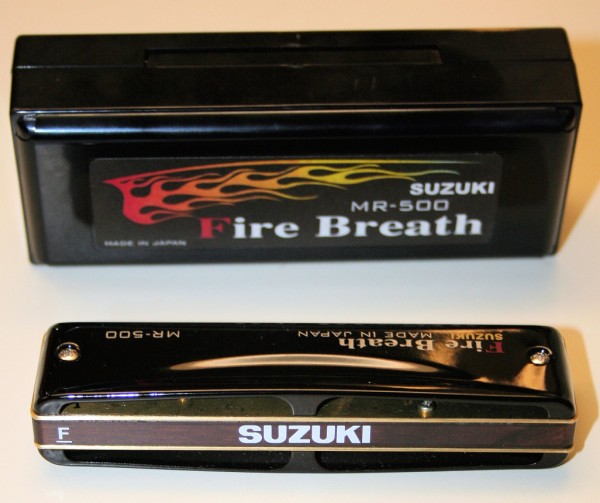
Suzuki
My first major purchase after my set of Johnsons (see below) was a $45 Suzuki Promaster in A, an all-metal harmonica with an aluminum comb - much more expensive than my playing talents deserve. But I was intrigued by the idea of a metal comb and wanted to hear what it sounded like, so I made the investment.
My first impression was, wow! What a difference after my inexpensive harps! Suddenly even my amateurish tooting sounded crisp, rich and full. I bought a second Promaster in G. Money may not buy love, but it sure can buy quality.
The harp is satisfyingly heavy and solid, the second heaviest I've purchased, after the Pipe Humming. It bends wonderfully. Smooth case that slides easily on the lips. The rear portion of the cover is supported by a central support. The reeds are phosphor-bronze, advertised as being "laser-tuned." There's a solid support for the case at the rear.
I love this harp. It's worth the cost if you're at all serious about your playing.
I was so impressed I ordered a valved version of the same harp in A, to compare it with. Valves - not to be confused with windsavers - are supposed to make overblow bends easier. Suzuki says, "Draw cycle valve system circulates air to allow note bending in the blow as well as the draw cycle. Its note bending abilities will make your music magical!" These valves are intended to let you play more notes than the standard diatonic provides. But the reviews of it online are mixed, some even negative and complain that the valves rattle or buzz. In my limited time practicing with the valved version, I didn't notice any significant improvement in playing, and find that sometimes - rarely, mind you - the valves seem to stick a bit and block the sound. Could just be my clumsy technique, however.
On the other hand, Brendan Power comments on the valved model, "A different approach to overblowing, but which is also intended to enhance the expressive and chromatic abilities of the diatonic harmonica, is to allow more notes to be bent in pitch. The Suzuki ProMaster MR350V is a half valved diatonic, which employes chromatic-style valves that work only on the lower pitched note in each air channel. This allows the lower note to be bent down in the same way as on a chromatic, giving the harp more expressiveness, while the higher notes can still be bent in the normal way. However, the valves alter the traditional breathy diatonic tone, and the valved bends are difficult to control as chromatic notes in their own right. Along with the concurrent rise of overblowing, these factors have meant that the half-valved diatonic has never achieved mainstream popularity."
When I first got my new harmonicas, I spent a couple of weeks learning to bend draw reeds again - and I think I can now do so with a modicum of ease and ability, although I still need more practice - but I've not really mastered blow bends yet (they're still sporadic and depends on the harmonica). I had hoped this harp will finally allow me to do so with greater skill. Obviously I need to work with it more to understand its subtleties. Until then, I can't find any large difference between it and the standard Promaster, either in the sound or in the bending, so I would recommend you purchase the standard model instead.
I was surprised the valved version of the Promaster weighs the same as the regular version. I had expected at least a small increase.
I also bought three Suzuki Bluesmaster harps, in G, F and Bb. The Bluesmaster has as stunning a sound as the Promaster, but at a lower cost. It seems to use the same phosphor reed plates but has a lighter plastic comb. I'd easily buy a set of these - they're far more affordable than the Promaster. Note the red comb on the A - C key is black to make it easier to see in a case.
So far, these Suzuki models have impressed me the considerably - sound, comfort, bending and looks are all top notch. And the prices are comparable with other premium makes. The support at the rear of the case is, however, not as large as the Promaster, but the case is gratifyingly solid. Overall these seem the best bang for the buck in Suzuki's lineup.
I picked up a Suzuki Overdrive in A, another $60 harmonica, from eBay. This harp has a new design with rear air holes in the cover and each reed having its own chamber. It is aimed at making bending easier. It's certainly a challenge for me.
The Overdrive is also up there in weight. This model has separate air holes at the back of the case (top and bottom, not rear) that, when you block them with a finger, increase air flow over the reeds, supposedly making it easier to overblow and bend. The case itself has no other back or side openings, just these 20 holes, each one for a separate reed.
The theory sounds good - you block the upper hole to overblow (which forces air down over the lower reed and gets the upper reed to warble a bit at the same time), and the block the lower to overdraw. But that requires some coordination and practice. If you block the upper hole when drawing, you cut off the air and don't get anything! Ditto if you block the lower while drawing. And of course I've managed to block both top and bottom simultaneously... The holes are small and closely placed, so trying to figure out just where to put your fingers is a challenge. Do you just target selective holes with fingertips or use a whole finger to block several at once?
This is obviously not a beginner's harp, although the results may prove worth the effort in the long run. I'm not sure I have the coordination or patience, however. It's an interesting approach, but I'm not convinced this is the best solution to improving overblow/draw capabilities (it's certainly simpler than the Bahnson solution).
The design also makes the Overdrive seem more muted than the standard
harp, probably because there isn't much space for the sound to expand
into or from, thanks to the sealed case.
Pat
Missin has a good page of comments and suggestions on how to play
and improve the Overdrive harp, if you're technically inclined. Pat also
points out that
Masaru Hashimoto who designed the Overdrive has a mechanical fix
(cutting the combs) that may make it even better. However, the fix
strikes as as undoing the design's intention.
One thing for sure: Suzuki is at the forefront of harmonica design with the Overdrive, Pipe Humming and other models. Almost everyone else sticks to the standard designs, while Suzuki goes out on a limb. Note that the cases on all of these models extends to the full size of the comb. I don't know if this affects the sound, or if it's just style.
There's also a Folkmaster, Hammond and a Pure Harp model from Suzuki I haven't tried (yet) but are on my wish list. Like the other models, these are all made in Japan.
Nov. 6. Got a Firebreath MR-500 in low F from an online Canadian seller, Musician's Web Store. Weighty harp because it has a rosewood comb (rosewood is the most popular wood for guitar fretboards).
Suzuki says, "Using Rosewood can produce a high velocity of sound and a broad range of mid and low overtones. These 'lows' help to create a complex bottom end which imparts a richness to the overall tone to the instrument. The re-designed reeds, which are the heart of the instrument, have been produced with the advanced player in mind. However, this new reed design makes it easier to play the instrument chromatically, right out of the box! The new Suzuki Reed plates allow ease of play, especially with overblow and overdraw techniques."
When comparing the Firebreath with the Bushman Delta Frost LF, there is a noticeable difference in tone between the two harps. The Bushman sounds brash and louder, while the Firebreath has more low end/mid tones and sounds more muted to my ear. This is clearly what harp players mean between bright (Bushman) and warm (Firebreath) tone qualities. It's a good sound, this harp has.
The case is enamel black and supported at the back by two metal tabs,
sealed on three sides like the Pro/Bluesmaster.
There's a small indentation top and bottom along the length of the case,
which makes holding the Firebreath quite comfortable. My Firebreath had
an unusual chemical odour, possibly from the rosewood sealants, which
dissipated considerably overnight, but still lingered the next day. I
hope it goes away entirely (Nov. 14: barely noticeable now).
The Firebreath is very playable, and responsive like all the Suzukis I've tried. It's
also shorter front-to-back than their Overdrive or Pro/Bluesmaster. It
seems a little quieter than the LF Bushman, but only marginally so. It
sells for double the cost of the Bluesmaster, but I question whether a
rosewood comb is really worth the difference. Stephen Schneider says the
Firebreath (and its companion Pure Harp) are among the rare few
off-the-shelf harps that are correctly gapped, so that must contribute
to the price. It's a good harmonica, maybe even a great one, but I think
the subtleties of proper gapping are lost on an amateur like me right
now. I'll
stick to the Bluesmaster as the best buy in the Suzuki line.
Suzuki's plastic carrying cases are the best I've seen from any manufacturer. Solid, well-made, nicely lined and substantially thick. While I appreciate that quality, I would prefer a few dollars off the cost and a slightly lower-quality case instead. Lee Oskar's cases snap together - an idea Suzuki should explore.
What surprised me is that only one of the local musicians I spoke with had ever heard of - much less played - a Suzuki harmonica. I think they're missing out on an excellent instrument. I've also read some very positive comments on the Harp mailing list about Suzuki's service.
MP3 samples at 160 kb/s: Suzuki Firebreath LF, Suzuki ProMaster G, Suzuki Bluesmaster G, Suzuki Promaster Valved A. Sound samples courtesy of my longtime musician friend and music teacher, engineer and performer extraordinaire, Rick Garner.
Would I purchase another Suzuki? Yes - Promaster, Bluesmaster,
and probably a Firebreath.
Would I recommend them to others? Yes, but not likely the Overdrive.
Rating (0-5): ****1/2
